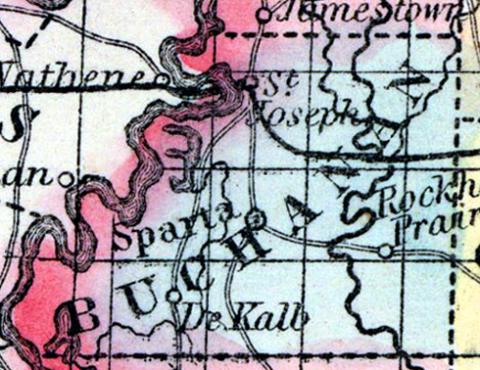BUCHANAN COUNTY, situated on the westerly boundary of Missouri on the east side of Missouri river. Area, 800 square miles. Seat of justice, Sparta. Pop. in 1840, 6,237 ; in 1850, 12,975. (Fanning's, 1853)
BUCHANAN, a county in the W. N. W. part of Missouri, bordering on the Missouri river, which separates it from the Indian Territory, has an area of 415 square miles. It is intersected by Little Platte river, which flows southward, and drained also by Castile and Livingston creeks. The soil is highly productive. Indian corn, wheat, oats, hay, cattle, swine, and butter are the staples. In 1850 this county produced 1,935,713 bushels of corn; 121,682 of wheat; 56,549 of oats; 1075 tons of hay, and 182,961 pounds of butter. The above quantity of Indian corn was the greatest produced by any county of the state. It contained 4 churches and 2 newspaper establishments. There were 625 pupils attending public schools. The projected railroad from the Mississippi river to the Missouri will pass through the county. The Missouri river is navigable by steamboats along the border of the county. Capital, St. Joseph. Population, 12,976, of whom 12,073 were free, and 902, slaves. (Baldwin's New and Complete Gazetteer of the United States..., 1854)
BUCHANAN COUNTY. This county is situated in the west-northwest part of the State, is bounded on the east by Clinton and De Kalb, on the north by Andrew, on the west by the Missouri River, which separates it from Kansas, and on the south by Platte County, and has an area of 415 square miles. Population in 1860, 23,675.
Physical Features.—This county is principally made up of undulating prairie land, and its appearance by Eastern travelers has been compared to a "rough sea," so gentle are the slopes and undulations. There is a good growth of timber along the margins of the streams, and here and there fine groves upon the prairies.
The Soil is generally deep and remarkably fertile, producing all kinds of grains, grasses, fruit, and vegetables found in this latitude. Some farmers have produced as high as 1500 pounds of hemp to the acre, 125 bushels of corn, and 30 bushels of wheat, 50 rye, 60 oats, etc., and fruit and root crops yield abundantly. The "Platte Country" has a world-wide fame for its fertility, and the deep soil but needs more farmers, and a thorough and systematic cultivation, to render it the best farming region of the State, if not in the Union.
Climate.—Situated in latitude 39° 30' north, the climate at St. Joseph is healthy, salubrious, and free from miasmatic influences. The statistics show this to have been an exceedingly healthy country up to the present time.
Educational Institutions.—There are twenty schools of different grades in St. Joseph. Besides those supported by the common school fund, are the following private institutions: Convent of the Sacred Heart, St. Joseph College, Female Seminary, Male and Female Seminary, Male Academy, German and English School, and "Third Ward School." In 1858 there were in the county 5427 pupils, of whom 2119 were taught during the year at a cost of $7896 70, and the sum of $1133 50 raised to build and repair school-houses. School money apportioned for 1859, $4533 30.
Religious Denominations.—The following list embraces the church organizations in St. Joseph: Episcopal, Presbyterian O. S., Presbyterian N. S., Presbyterian Cumberland, Methodist Episcopal, English and German, Christian, Baptist, and Roman Catholic.
Benevolent Societies.—The Free and Accepted Masons, I. O. O. F., and Sons of Malta, have each one or more lodges in St. Joseph. The "Young Men's Literary Association" and the "St. Joseph Institute" are each in a prosperous condition.
Inducements to Immigration.—Farmers will find in this county prairie or timber, bottom or table-land very fertile, adapted to the growth of as great a variety of productions as any other part of the Union. In the varying qualities of the rich soil, and the equal temperature of the climate, they, have all the desirable elements of agricultural wealth. For the production of cereals or grasses, root crops, fruit, or grape culture, the soil and climate will be found admirably adapted. Manufacturers will here find a wide field for the employment of their capital and energy. The extensive and increasing home demand for all articles of manufacture, together with the abundance of raw materials, point to St. Joseph as the • natural location for a large manufacturing city. Now nearly every article in use bears the mark of foreign workshops: the farming implements, mill machinery, household furniture, woolen, and cotton fabrics, boots and shoes, and scores of other articles could be manufactured here to advantage, and thus support a large population, and add greatly to the revenue of the county and the State. Mechanics will see in the rapid growth of the city and country unmistakable evidences of the prosperity and success of every branch of their business; while capitalists will find rare opportunities for profitable investment, from which they can realize a handsome return, and at the same time contribute toward the development of the resources of this portion of our noble State. (Parker's Missouri as it is in 1867..., 1867)

